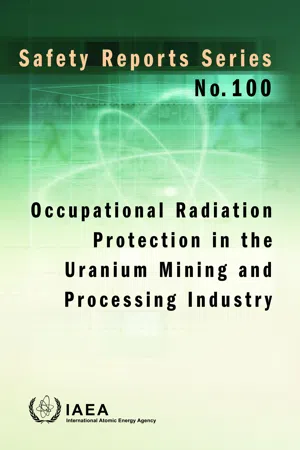1. INTRODUCTION
1.1. Background
Natural uranium is the dominant fuel for global nuclear power programmes, and an increase in the momentum of the prospecting, mining and processing of uranium is inevitable in the future as more countries adopt national nuclear power programmes. The World Nuclear Association reports:
“• In the last 60 years uranium has become one of the world’s most important energy minerals.
• It is mined and concentrated similarly to many other metals.
…….
“Uranium is a naturally occurring element with an average concentration of 2.8 parts per million in the Earth’s crust. Traces of it occur almost everywhere. It is more abundant than gold, silver or mercury, about the same as tin and slightly less abundant than cobalt, lead or molybdenum.”
The three main methods of producing uranium are underground mining, open pit mining and in situ leaching (ISL) (sometimes referred to as in situ recovery, ISR). Conventional mines, either underground or open pit, are usually associated with a mill, where the ore is crushed, ground and then leached to dissolve the uranium and separate it from the host ore. At the mill of a conventional mine or at the treatment plant of an ISL operation, the uranium which is now in solution is then separated by ion exchange before being precipitated, dried and packed. The product, uranium oxide concentrate, is also referred to as yellow cake and mixed uranium oxide (U3O8, UO4).
Uranium can also be recovered as a by-product from phosphate fertilizer production and from the mining of other minerals, such as copper and gold, when the ores contain economically exploitable quantities of uranium. In such situations, the treatment process to recover uranium can be more complex.
During uranium mining and processing, workers may be exposed externally to gamma rays emitted from the ores, process materials, products and tailings. Internal exposure can arise from the inhalation of long lived radionuclide dust (LLRD) and radon and radon decay products (RDP), and through absorption, ingestion and wound contamination.
1.2. Objective
The objective of this publication is to provide detailed information to assist regulatory bodies and industry operators in implementing a graded approach to the protection of workers against exposures associated with uranium mining and processing. This information will also serve as the basis for creating a common understanding among various stakeholders (e.g. regulators, operators, workers and their representatives, health, safety and environmental professionals) about the radiological aspects of the various processes involved and the ways in which these aspects can be addressed appropriately and effectively.
1.3. Scope
This publication describes the methods of production in the uranium industry and provides practical information on the radiological risks to workers in exploring, mining and processing. This publication also describes the methods of assessing and controlling the radiological risks based on the application of the appropriate IAEA safety standards and good working practices. This information has been compiled from published literature, from unpublished data provided by the contributors to this publication and from numerous experts with extensive experience in the various sectors of the uranium mining and processing industry. Guidance provided here, describing good practice, represents expert opinion but does not constitute recommendations made on the basis of a consensus of Member States.
1.4. Structure
Section 2 provides an overview of the uranium industry and the general radiation protection aspects of various uranium mining and processing methods. Section 3 summarizes the radiation protection principles and considerations that apply to the industry and the application of the international standards, the graded approach to regulation and specific aspects of radionuclides in the uranium decay series. Section 4 addresses the general methodology for control with the introduction of occupational health and safety considerations, the hierarchy of control, dose reduction and exposure pathways. Section 5 explores the arrangements for monitoring and dose assessment of various exposure pathways, and Section 6 presents the occupational radiation protection programmes during the life cycle of different uranium mining and processing methods and stages. The six appendices begin with a description of the Information System on Uranium Mining Exposure (UMEX) survey, which is followed by the methods and analysis of the survey results, and concludes with technical details on the assessment and control of the major exposure pathways.
2. OVERVIEW OF THE URANIUM INDUSTRY AND GENERAL RADIATION PROTECTION
2.1. Global uranium production
With the current interest in nuclear power, there has been an increase in uranium exploration and in the development of new uranium mining and processing facilities in many countries. World uranium production was 55 975 tU as of 1 January 2015 [1, 2]. This uranium production occurred in 16 different countries at approximately 50 different mining and processing facilities. Uranium production has increased by 50% since 2007; and because of this increased demand, the numbers of workers in the uranium mining and processing industry is set to increase substantially within a few years.
In 2012, as part of UMEX, the IAEA developed a questionnaire that was distributed to 36 operators in uranium producing countries. The responses to this first questionnaire were received in 2013. The information in Appendix I is based on the analysis of the questionnaire ...
